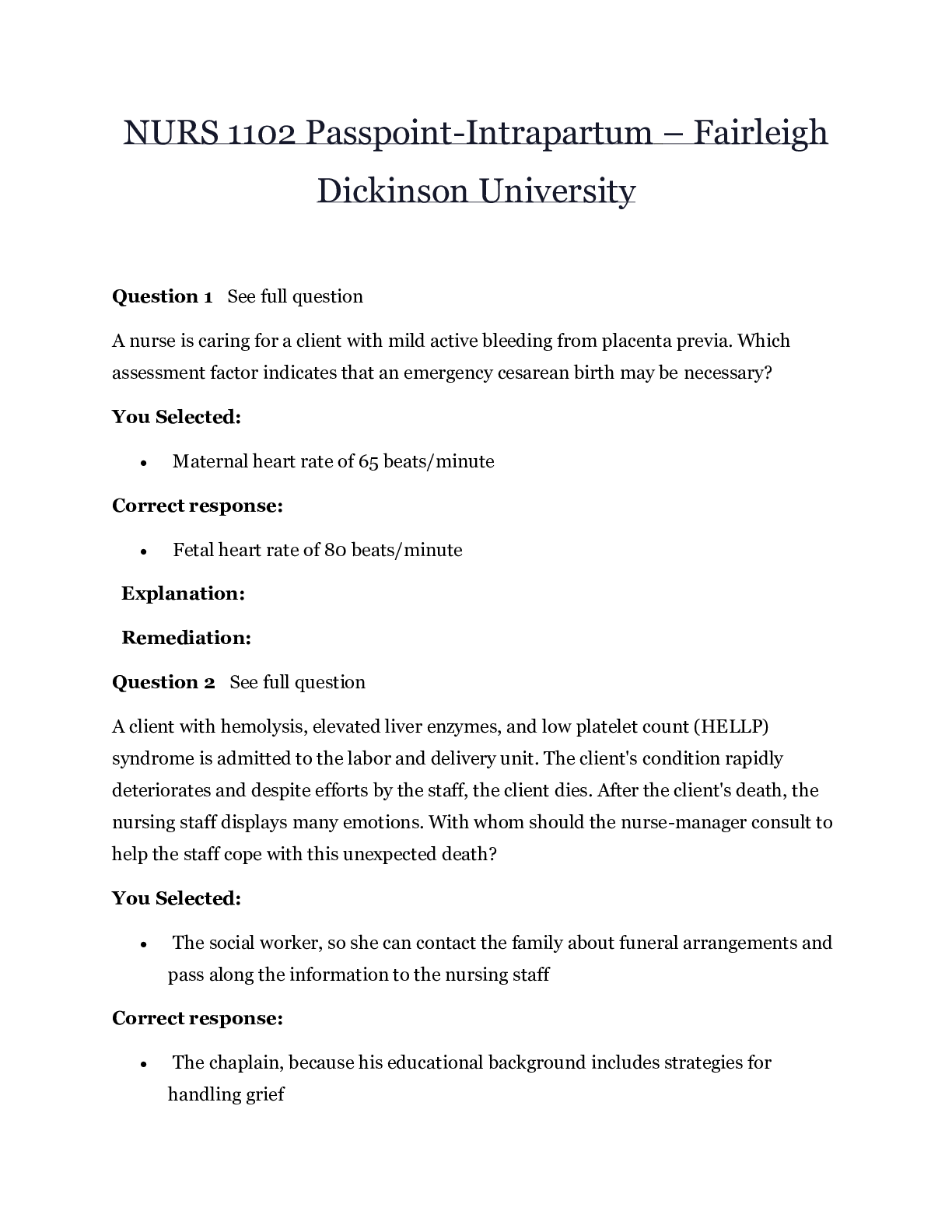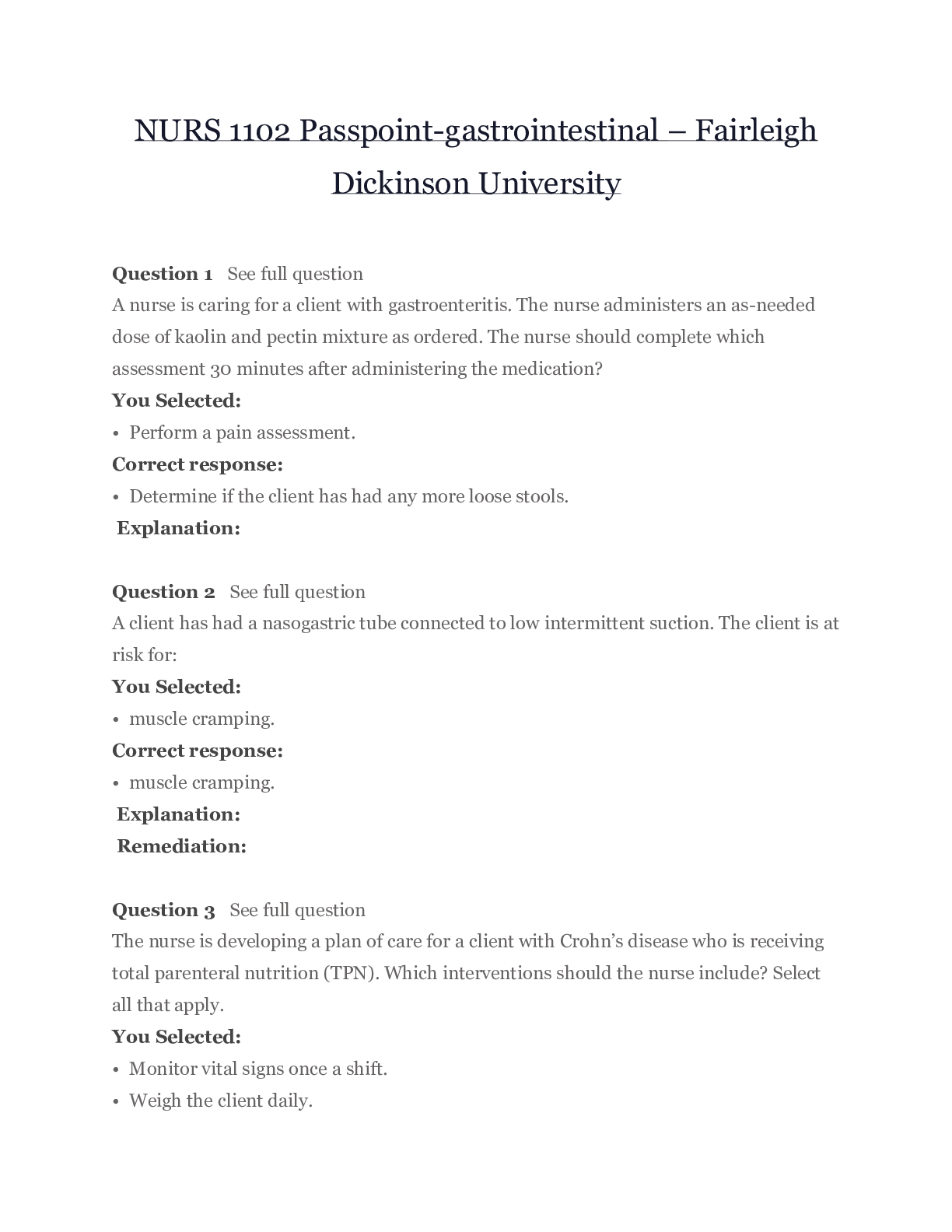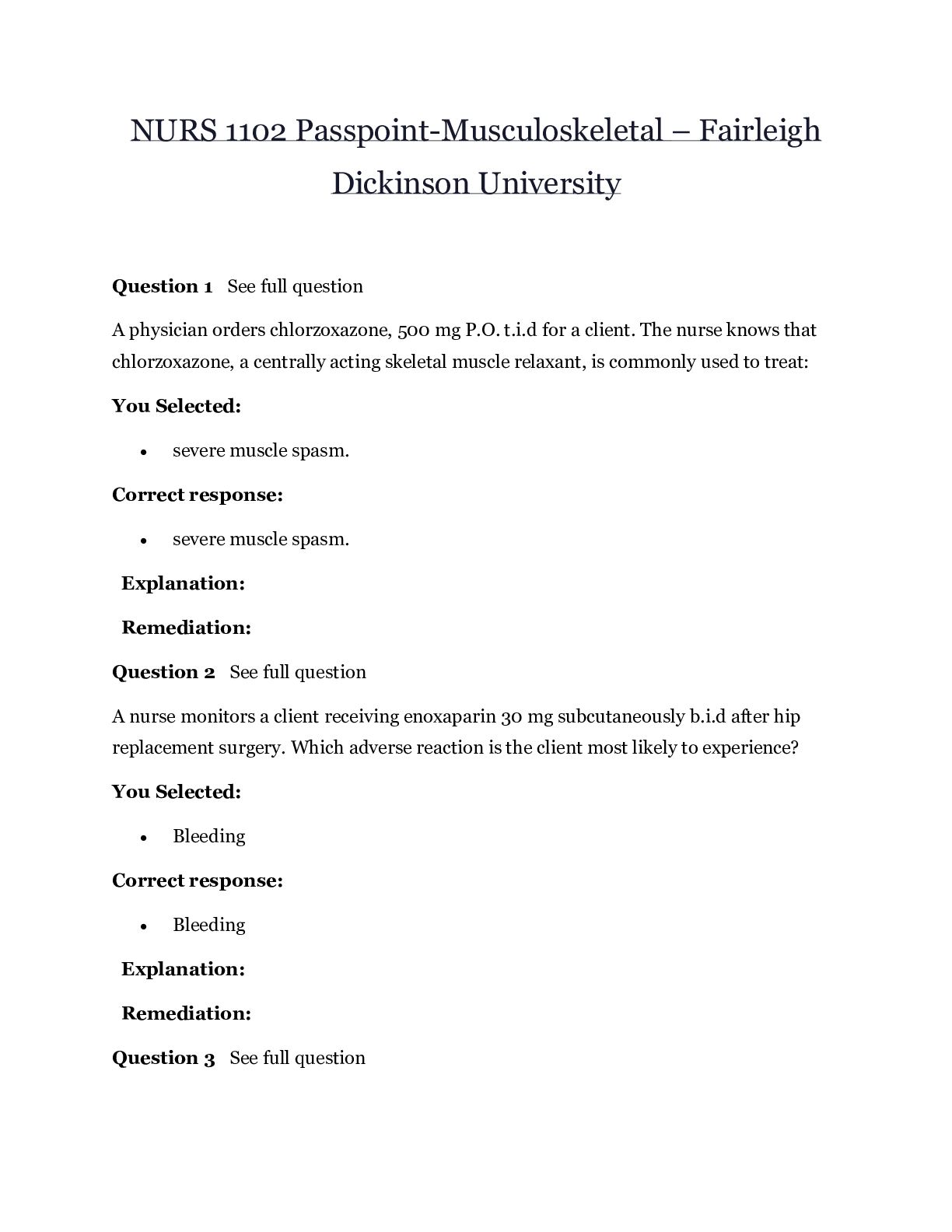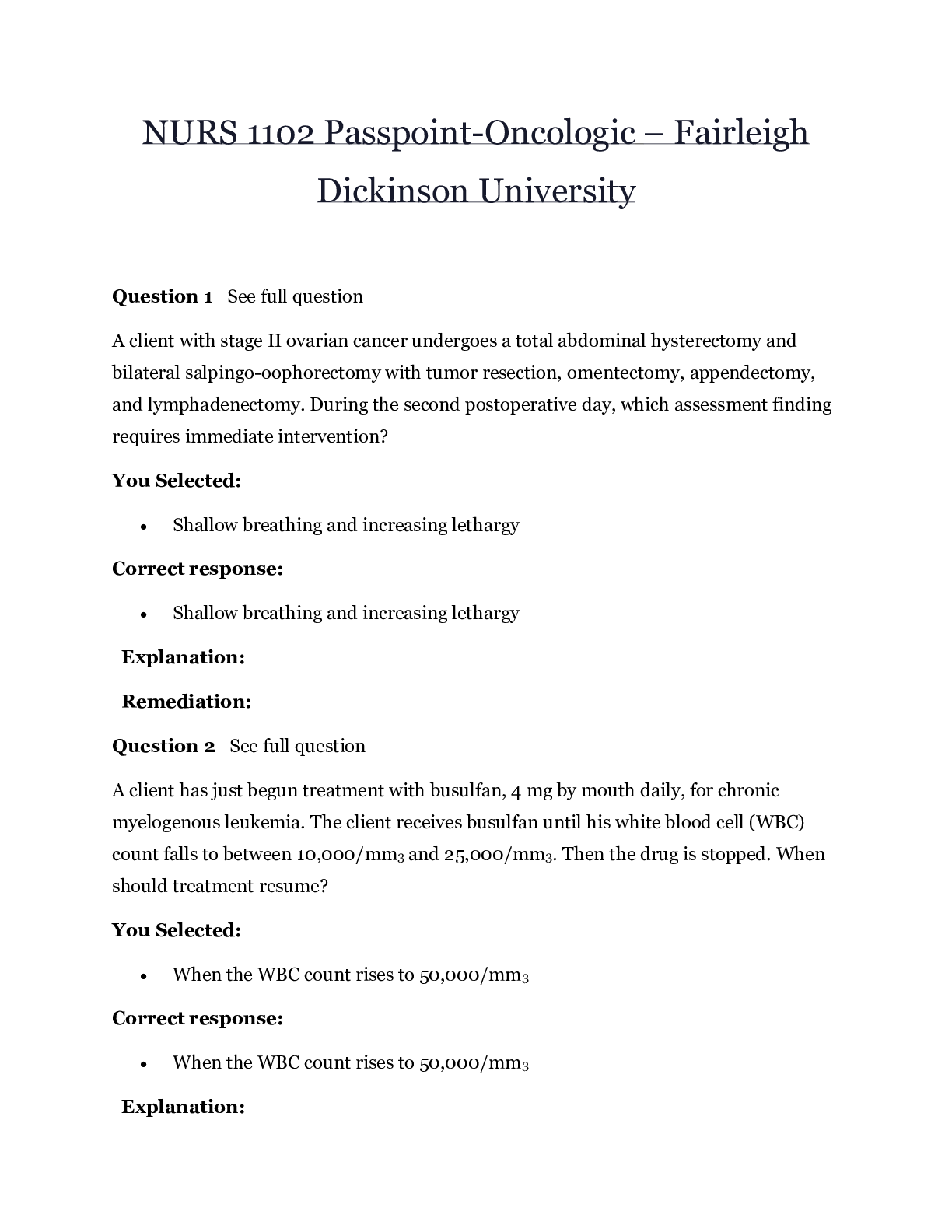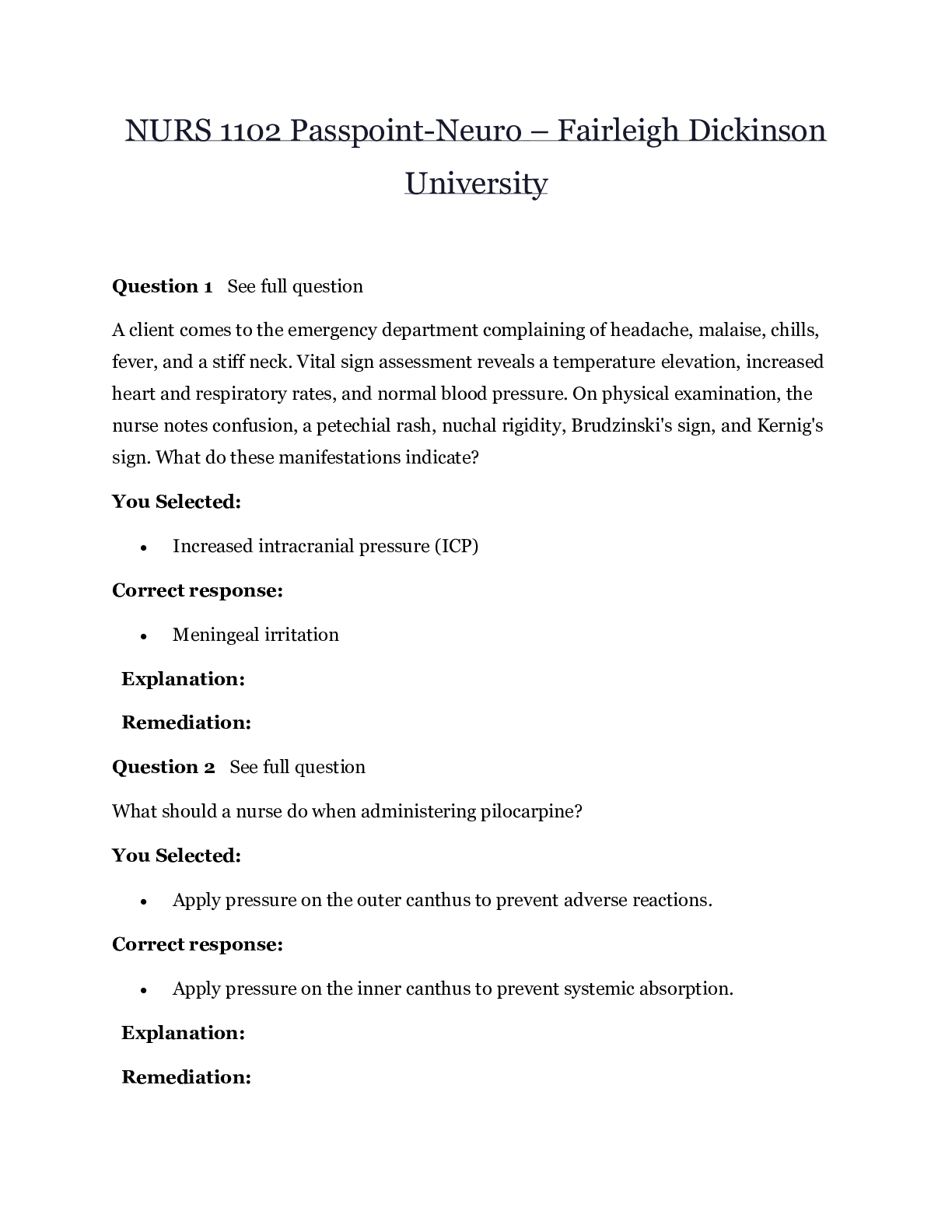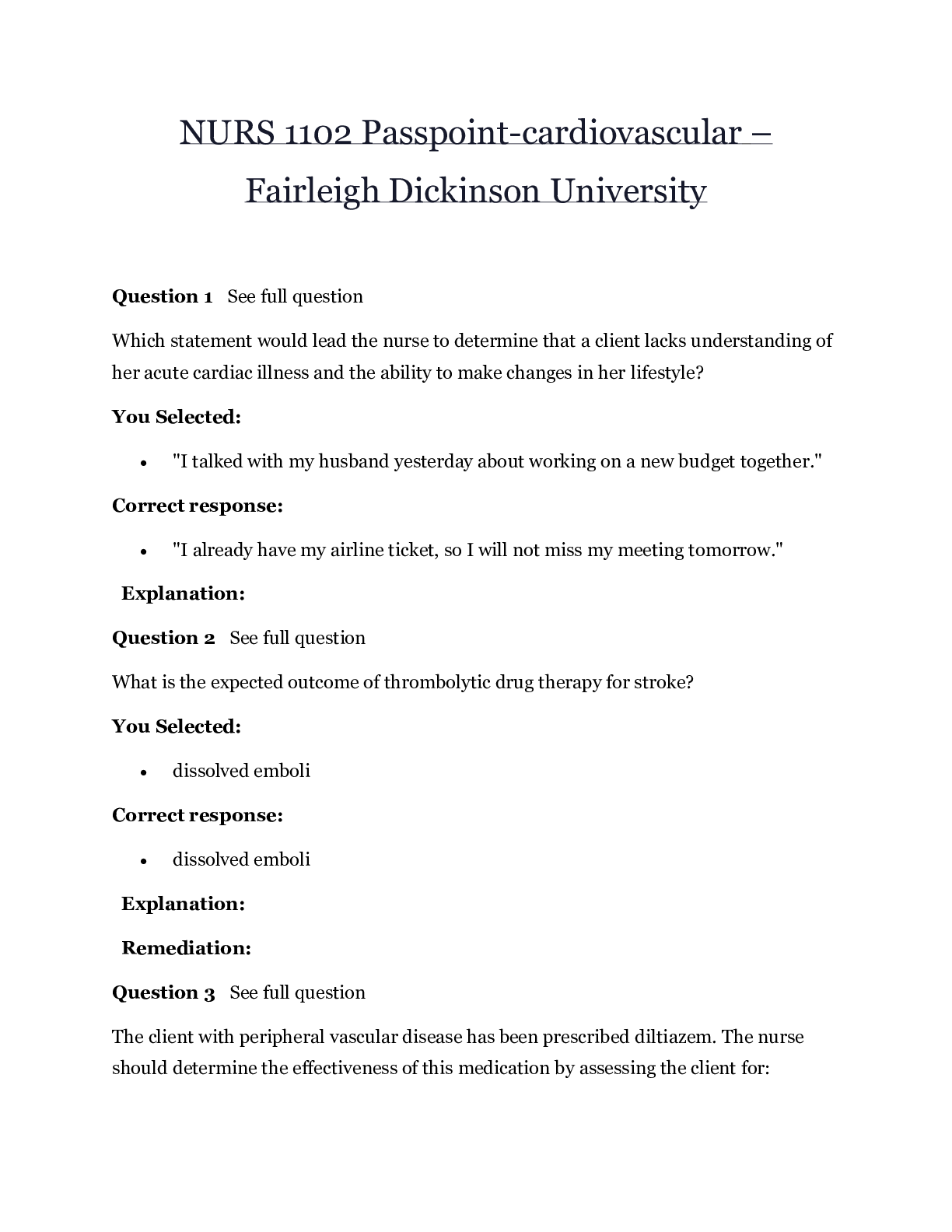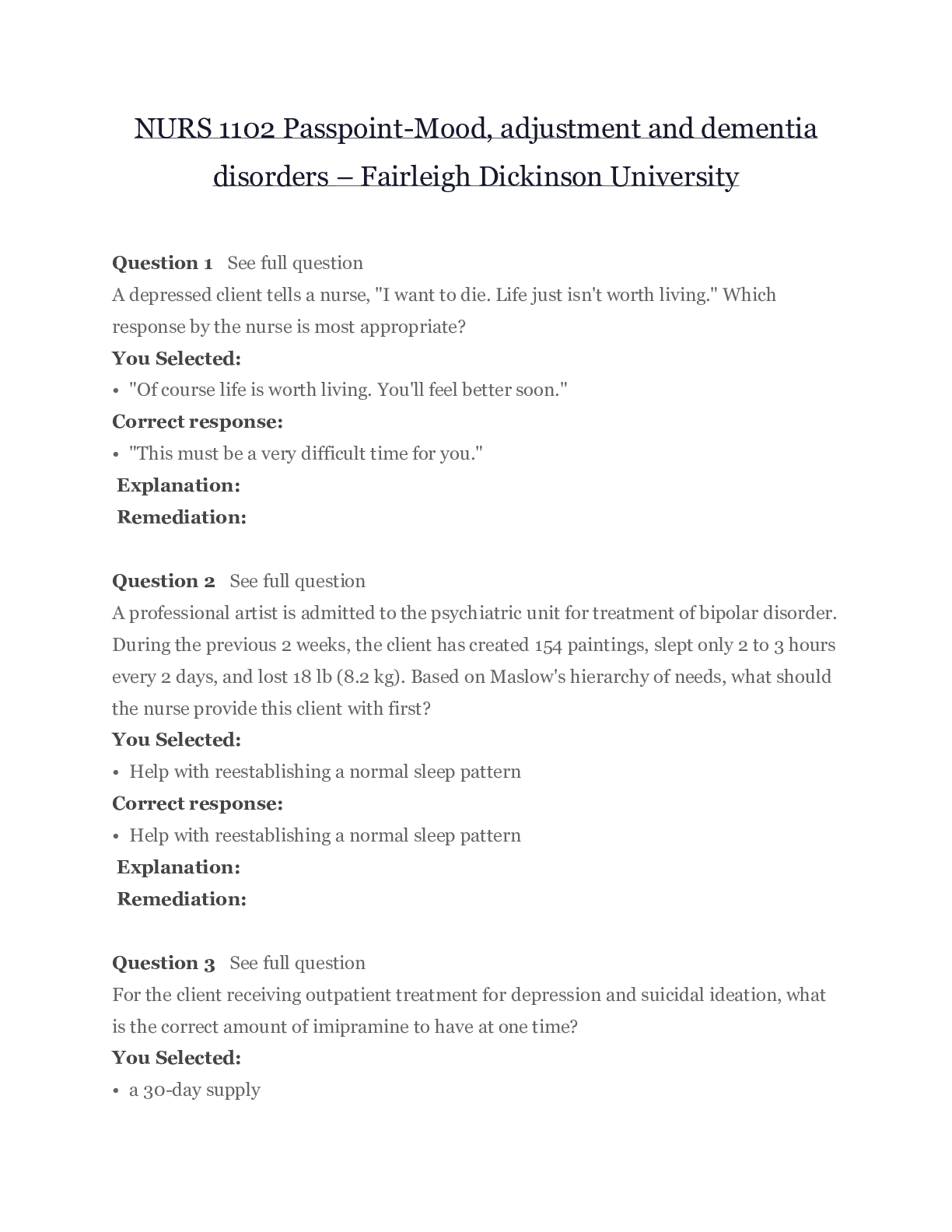*NURSING > EXAM > NURS 1102 Passpoint-Respiratory – Fairleigh Dickinson University | NURS1102 Passpoint-Respiratory (All)
NURS 1102 Passpoint-Respiratory – Fairleigh Dickinson University | NURS1102 Passpoint-Respiratory
Document Content and Description Below
NURS 1102 Passpoint-Respiratory – Fairleigh Dickinson University Question 1 See full question A client with asthma has been taking theophylline as ordered. Now, the client's blood theophyl... line level is 4.8 mcg/ml. Which dosage change will the physician order? You Selected: • Maintain the dose. Correct response: • Increase the dose. Explanation: Remediation: Question 2 See full question A nurse notices that a client admitted for exacerbation of chronic obstructive pulmonary disease is short of breath. The client has signed an advance directive indicating that he doesn't want to be resuscitated. The nurse should: You Selected: • not provide any care. Correct response: • check the client's oxygen saturation. Explanation: Remediation: Question 3 See full question The nurse is teaching a client who will be undergoing a lung resection. The client is told that two chest tubes will be placed during surgery. The nurse explains that the purpose of the lower chest tube is to: You Selected: • remove air. Correct response: • remove fluid. Explanation: Remediation: Question 4 See full question The nurse is planning to teach the client how to properly use a metered-dose inhaler to treat asthma. The nurse should tell the client to: You Selected: • cough and deep-breathe before inhaling the medication. Correct response: • rinse the mouth after each use of a steroid inhaler. Explanation: Question 5 See full question The nurse has administered aminophylline to a client with emphysema. The medication is effective when there is: You Selected: • efficient pulmonary circulation. Correct response: • relaxation of smooth muscles in the bronchioles. Explanation: Question 6 See full question An adolescent with cystic fibrosis has been hospitalized several times. On the latest admission, the client has labored respirations, fatigue, malnutrition, and failure to thrive. Which initial nursing actions are most important? You Selected: • applying an oximeter and initiating respiratory therapy Correct response: • applying an oximeter and initiating respiratory therapy Explanation: Remediation: Question 7 See full question After a total laryngectomy, the client has a feeding tube. The feeding tube is effective if the tube feedings: You Selected: • prevent fistula formation. Correct response: • meet the fluid and nutritional needs of the client. Explanation: Remediation: Question 8 See full question A client with bacterial pneumonia is to be started on IV antibiotics. Which diagnostic tests must be completed before antibiotic therapy begins? You Selected: • red blood cell count Correct response: • sputum culture Explanation: Remediation: Question 9 See full question The nurse assesses the respiratory status of a client who is experiencing an exacerbation of chronic obstructive pulmonary disease (COPD) secondary to an upper respiratory tract infection. Which findings is expected? You Selected: • coarse crackles and rhonchi Correct response: • coarse crackles and rhonchi Explanation: Remediation: Question 10 See full question A client is prescribed metaproterenol via a metered-dose inhaler, two puffs every 4 hours. The nurse instructs the client to report which adverse effect? You Selected: • decreased pulse rate Correct response: • irregular heartbeat Explanation: Question 11 See full question A client who underwent a lobectomy and has a water-seal chest drainage system is breathing with a little more effort and at a faster rate than 1 hour ago. The client's pulse rate is also increased. The nurse should: You Selected: • check the tubing to ensure that the client is not lying on it or kinking it. Correct response: • check the tubing to ensure that the client is not lying on it or kinking it. Explanation: Remediation: Question 12 See full question Which action should the nurse anticipate in a client who has been diagnosed with acute respiratory distress syndrome (ARDS)? You Selected: • use of a nasal cannula Correct response: • mechanical ventilation Explanation: Remediation: Question 13 See full question When performing the Heimlich maneuver on a conscious adult victim, the rescuer delivers inward and upward thrusts specifically: You Selected: • above the umbilicus. Correct response: • below the xiphoid process and above the umbilicus. Explanation: Remediation: Question 14 See full question While reviewing the arterial blood gas values of a client with emphysema, the nurse should identify which PaCO2 values as indicating the need for immediate intervention? You Selected: • 80 mm Hg Correct response: • 80 mm Hg Explanation: Remediation: Question 15 See full question An expected outcome of theophylline ethylenediamine when administered to a client with chronic obstructive pulmonary disease is: You Selected: • strengthen myocardial contractions. Correct response: • relax bronchial smooth muscle. Explanation: Question 16 See full question After suctioning a client’s tracheostomy tube, the nurse waits a few minutes before suctioning again. The nurse should use intermittent suction primarily to help prevent: You Selected: • depriving the client of sufficient oxygen supply. Correct response: • depriving the client of sufficient oxygen supply. Explanation: Remediation: Question 17 See full question Which assessment finding puts a client at increased risk for epistaxis? You Selected: • History of nasal surgery Correct response: • Cocaine use Explanation: Remediation: Question 18 See full question A client with chronic obstructive pulmonary disease (COPD) is intubated and placed on continuous mechanical ventilation. Which equipment is most important for the nurse to keep at this client's bedside? You Selected: • Oxygen analyzer Correct response: • Manual resuscitation bag Explanation: Remediation: Question 19 See full question A client is receiving supplemental oxygen. When determining the effectiveness of oxygen therapy, which arterial blood gas value is most important? You Selected: • Bicarbonate (HCO3–) Correct response: • Partial pressure of arterial oxygen (PaO2) Explanation: Remediation: Question 20 See full question A client with influenza is admitted to an acute care facility. The nurse monitors the client closely for complications. What is the most common complication of influenza? You Selected: • Pulmonary edema Correct response: • Pneumonia Explanation: Remediation: Question 21 See full question A home health nurse is visiting a home care client with advanced lung cancer. Upon assessing the client, the nurse discovers wheezing, bradycardia, and a respiratory rate of 10 breaths/minute. These signs are associated with which condition? You Selected: • Delirium Correct response: • Hypoxia Explanation: Remediation: Question 22 See full question The amount of air inspired and expired with each breath is called: You Selected: • vital capacity. Correct response: • tidal volume. Explanation: Remediation: Question 23 See full question For a client who has a chest tube connected to a closed water-seal drainage system, the nurse should include which action in the care plan? You Selected: • Keeping the collection chamber at chest level Correct response: • Measuring and documenting the drainage in the collection chamber Explanation: Remediation: Question 24 See full question Before weaning a client from a ventilator, which assessment parameter is the most important for the nurse to obtain? You Selected: • Electrocardiogram (ECG) results Correct response: • Baseline arterial blood gas (ABG) levels Explanation: Remediation: Question 25 See full question A nurse provides care for a client receiving oxygen from a nonrebreather mask. Which nursing intervention has the highest priority? You Selected: • Posting a "No smoking" sign over the client's bed Correct response: • Assessing the client's respiratory status, orientation, and skin color Explanation: Remediation: Question 26 See full question A nurse is developing a teaching plan for a client with asthma. Which teaching point has the highest priority? You Selected: • Avoid goose down pillows. Correct response: • Take ordered medications as scheduled. Explanation: Remediation: Question 27 See full question During the insertion of a rigid scope for bronchoscopy, a client experiences a vasovagal response. The nurse should expect: You Selected: • the client to experience bronchodilation. Correct response: • a drop in the client's heart rate. Explanation: Remediation: Question 28 See full question When caring for a client with acute respiratory failure, the nurse should expect to focus on resolving which set of problems? You Selected: • Hypotension, hyperoxemia, and hypercapnia Correct response: • Hypercapnia, hypoventilation, and hypoxemia Explanation: Remediation: Question 29 See full question Which intervention is most appropriate for a client with an arterial blood gas (ABG) of pH 7.5, a partial pressure of arterial carbon dioxide (PaCO2) of 26 mm Hg, oxygen (O2) saturation of 96%, bicarbonate (HCO3-) of 24 mEq/L, and a PaO2 of 94 mm Hg? You Selected: • Administer an ordered decongestant. Correct response: • Instruct the client to breathe into a paper bag. Explanation: Remediation: Question 30 See full question Which statement by the mother of a neonate diagnosed with bronchopulmonary dysplasia (BPD) indicates effective teaching? You Selected: • "My baby may have seizures later on in life because of this condition." Correct response: • "My baby may require long-term respiratory support." Explanation: Remediation: Question 31 See full question What is an expected outcome for an adult client with well-controlled asthma? You Selected: • Temperature remains lower than 100° F (37.8° C). Correct response: • Breath sounds are clear. Explanation: Remediation: Question 32 See full question When attempting to check the pupils of a client scheduled to receive general anesthesia, the nurse notices that the client has trouble tilting the head back. What is the primary concern related to this finding? You Selected: • The client is at risk for postoperative neck pain. Correct response: • The client is at risk for difficult intubation. Explanation: Remediation: Question 33 See full question A nurse is caring for a client with pneumonia who was prescribed ceftriaxone oral suspension 600 mg once daily. The medication label indicates that the strength is 125 mg/5 ml. How many milliliters of medication would the nurse pour to administer the correct dose? Record your answer as a whole number. Your Response: • 24 Correct response: • 24 Explanation: Remediation: Question 34 See full question Which of the following may occur with respiratory acidosis? You Selected: • Decreased pulse Correct response: • Increased intracranial pressure (ICP) Explanation: Remediation: Question 35 See full question A client with emphysema is at a greater risk for developing what acid–base imbalance? You Selected: • Chronic metabolic acidosis Correct response: • Chronic respiratory acidosis Explanation: Remediation: Question 36 See full question The nurse is caring for a client with chronic obstructive pulmonary disease. The client reports that he is having difficulty breathing and is feeling fatigued. The nurse realizes that this client is at high risk for which condition? You Selected: • Respiratory acidosis Correct response: • Respiratory acidosis Explanation: Remediation: Question 37 See full question The nurse is caring for a client diagnosed with chronic obstructive pulmonary disease (COPD) and experiencing respiratory acidosis. The decrease in pH exists because the client's lungs: You Selected: • are unable to exchange oxygen and carbon dioxide. Correct response: • are not able to blow off carbon dioxide. Explanation: Remediation: Question 38 See full question Upon analysis of a client's arterial blood gas results, the nurse determines that the concentration of carbon dioxide and hydrogen ions are elevated and the oxygen in the arterial blood is decreased. What respiratory assessment findings would the nurse anticipate to observe in a client with these arterial blood gas results? You Selected: • Decrease in rate and depth of respirations Correct response: • Increase in rate and depth of respirations Explanation: Remediation: Question 39 See full question A nurse recognizes that a client with tuberculosis needs further teaching when the client states: You Selected: • "It will be necessary for the people I work with to take medication." Correct response: • "It will be necessary for the people I work with to take medication." Explanation: Remediation: Question 40 See full question A Spanish-speaking client admitted with tuberculosis notes, through an interpreter, concerns about paying for needed medications. The nurse should: You Selected: • collaborate with the social worker to investigate possible availability of funds. Correct response: • collaborate with the social worker to investigate possible availability of funds. Explanation: Question 41 See full question Which registered nurse should be assigned to the client who had a chest tube inserted yesterday? You Selected: • A registered nurse that use to work on the cardiovascular unit Correct response: • A registered nurse that use to work on the cardiovascular unit Explanation: Question 42 See full question The nurse is aware that the best position for a client with impaired gas exchange is what? You Selected: • High Fowler's Correct response: • High Fowler's Explanation: Remediation: Question 43 See full question The nurse is assessing a client who has a chest tube connected to a water-seal chest tube drainage system. According to the illustration shown, what should the nurse do? You Selected: • Notify the health care provider (HCP) of the amount of chest tube drainage. Correct response: • Lower the drainage system to maintain gravity flow. Explanation: Remediation: Question 44 See full question The nurse is suctioning a client’s tracheobronchial tree. Identify the area to which the nurse should advance the catheter. You Selected: • Your selection and the correct area, market by the green box. Explanation: Remediation: Question 45 See full question A client returns from a laryngectomy and begins to cough violently, dislodging the tracheostomy tube. What is the priority action of the nurse? You Selected: • Assess the client’s oxygen saturation and notify the healthcare provider. Correct response: • Mask ventilate the client and prepare for orotracheal intubation when the healthcare provider arrives. Explanation: Remediation: Question 46 See full question A nurse is caring for a client with influenza who becomes agitated and restless. Which of the following is the priority nursing action? You Selected: • Assess the client’s level of consciousness Correct response: • Assess the client’s lungs and check the oxygen saturation Explanation: Question 47 See full question A client with chronic obstructive pulmonary disease (COPD) has developed tachypnea, dyspnea, and oxygen saturation (SaO2) of 90%. Which of the following actions by the nurse is most appropriate? You Selected: • Place the client in the Trendelenburg position Correct response: • Assist the client to sit in a chair and lean slightly forward with hands on the knees Explanation: Remediation: Question 48 See full question A nurse is reviewing orders for a client having an acute asthma attack. Which of the following medications should the nurse administer? You Selected: • Triamcinolone two puffs per metered-dose inhaler Correct response: • Albuterol 2.5 mg per nebulizer Explanation: Remediation: Question 49 See full question The nurse assesses that a client is restless in the immediate postoperative period. The nurse should first: You Selected: • apply wrist restraints. Correct response: • administer oxygen. Explanation: Question 50 See full question A client has had a central venous pressure line inserted. The nurse should immediately report which sign to the health care provider (HCP)? You Selected: • sharp pain on the affected side Correct response: • sharp pain on the affected side Question 1 See full question After receiving an oral dose of codeine for an intractable cough, a client asks the nurse, "How long will it take for this drug to work?" How should the nurse respond? You Selected: • 4 hours Correct response: • 30 minutes Explanation: Question 2 See full question A competent client requiring long-term mechanical ventilation privately tells a nurse that he/she wants the ventilator withdrawn. Which response by the nurse is best? You Selected: • "You're asking us to do something we can't do." Correct response: • "Tell me how you are feeling." Explanation: Remediation: Question 3 See full question A nurse preparing to administer medications on the respiratory floor is using the computerized medication-dispensing system. Her password isn't working. The nurse should: You Selected: • override the machine and deliver the medications. Correct response: • ask computer support to reset her password. Explanation: Remediation: - - - - - - - - - - - - - - - - - - - - - - - -- - - Question 3 See full question Which action should the nurse anticipate in a client who has been diagnosed with acute respiratory distress syndrome (ARDS)? You Selected: • mechanical ventilation Correct response: • mechanical ventilation Explanation: Remediation: Question 4 See full question After teaching a client how to instill nose drops, the nurse evaluates that the client’s technique is correct when the client: You Selected: • lies supine for several minutes after instilling the drops. Correct response: • lies supine for several minutes after instilling the drops. Explanation: Remediation: Question 5 See full question The nurse instructs the unlicensed assistive personnel (UAP) on how to care for a client with chest tubes that are connected to water-seal drainage. The nurse should instruct the UAP to: You Selected: • mark the time and amount of drainage on the collection container. Correct response: • mark the time and amount of drainage on the collection container. Explanation: Remediation: Question 6 See full question A client is being prepared for a bronchoscopy. The nurse can delegate which task to the unlicensed assistive personnel (UAP)? You Selected: • placing the client on NPO status Correct response: • placing the client on NPO status Explanation: Remediation: Question 7 See full question Oxygen at the rate of 2 liters per minute through nasal cannula is prescribed for a client with chronic obstructive pulmonary disease (COPD). Which of the following statements best describes why the oxygen therapy is maintained at a relatively low concentration? You Selected: • The client’s respiratory center is so used to high carbon dioxide and low oxygen levels that changing these levels may eliminate his stimulus for breathing. Correct response: • The client’s respiratory center is so used to high carbon dioxide and low oxygen levels that changing these levels may eliminate his stimulus for breathing. Explanation: Remediation: Question 8 See full question When suctioning a tracheostomy tube 3 days following insertion, what should the nurse do? You Selected: • Use a sterile catheter each time the client is suctioned. Correct response: • Use a sterile catheter each time the client is suctioned. Explanation: Remediation: Question 9 See full question A nurse assesses arterial blood gas results for a client in acute respiratory failure (ARF). Which of the following results are consistent with this disorder? You Selected: • pH 7.28, PaO2 50 mm Hg Correct response: • pH 7.28, PaO2 50 mm Hg Explanation: Remediation: Question 10 See full question Which intervention will the nurse expect for a client with a positive tuberculin skin test? You Selected: • Prepare the client for a chest X-ray Correct response: • Prepare the client for a chest X-ray Question 1 See full question The nurse interprets which finding as an early sign of acute respiratory distress syndrome (ARDS) in a client at risk? You Selected: • hypoxia not responsive to oxygen therapy Correct response: • hypoxia not responsive to oxygen therapy Explanation: Remediation: Question 2 See full question The client with a total laryngectomy receives tube feedings to meet fluid and nutrition needs. The expected outcome of tube feedings is to prevent: You Selected: • rupture of the suture line. Correct response: • rupture of the suture line. Explanation: Question 3 See full question The nurse is discussing a treatment plan for mononucleosis with an adolescent. The nurse emphasizes that the client must: You Selected: • complete the entire course of antibiotics. Correct response: • avoid contact sports and vigorous exercise for 2 to 4 weeks. Explanation: Remediation: Question 4 See full question A client with chronic obstructive pulmonary disease (COPD) is recovering from a myocardial infarction. Because the client is extremely weak and can't produce an effective cough, the nurse should monitor closely for: You Selected: • pleural effusion. Correct response: • atelectasis. Explanation: Remediation: Question 5 See full question A nurse observes constant bubbling in the water-seal chamber of a closed chest drainage system. What should the nurse conclude? You Selected: • The system has an air leak. Correct response: • The system has an air leak. Explanation: Remediation: Question 6 See full question A positive tuberculin skin test indicates that a client: You Selected: • has produced an immune response. Correct response: • has produced an immune response. Explanation: Remediation: Question 7 See full question A client has a sucking stab wound to the chest. Which action should the nurse take first? You Selected: • Apply a dressing over the wound and tape it on three sides. Correct response: • Apply a dressing over the wound and tape it on three sides. Explanation: Remediation: Question 8 See full question A 79-year-old client is admitted to the hospital with a diagnosis of bacterial pneumonia. While obtaining the client’s health history, the nurse learns that the client has osteoarthritis, follows a vegetarian diet, and is very concerned with cleanliness. Which client information would most likely be a predisposing factor for the diagnosis of pneumonia? You Selected: • age Correct response: • age Explanation: Remediation: Question 9 See full question The nurse administers theophylline to a client. When evaluating the effectiveness of this medication, the nurse should assess the client for: You Selected: • less difficulty breathing Correct response: • less difficulty breathing Explanation: Remediation: Question 10 See full question The nurse is making rounds and observes the client who had a tracheostomy tube inserted 2 days ago (see figure). The nursing policy manual recommends use of the gauze pad. The nurse should: You Selected: • make sure the gauze pad is dry and the client is in a comfortable position. Correct response: • make sure the gauze pad is dry and the client is in a comfortable position. Explanation: Question 1 See full question A client with chronic sinusitis comes to the outpatient department complaining of headache, malaise, and a nonproductive cough. When examining the client's paranasal sinuses, the nurse detects tenderness. To evaluate this finding further, the nurse should transilluminate the: You Selected: • frontal sinuses only. Correct response: • frontal and maxillary sinuses. Explanation: Remediation: Question 2 See full question A client with an exacerbation of chronic obstructive pulmonary disease (COPD) is admitted to the hospital. Which nursing diagnosis requires the nurse to collaborate with other health team members to achieve the best outcome for the client? You Selected: • Impaired gas exchange Correct response: • Impaired gas exchange Explanation: Remediation: Question 3 See full question A physician orders a palliative care consult for a client with end-stage chronic obstructive pulmonary disease who wishes no further medical intervention. Which step should the nurse anticipate based on her knowledge of palliative care? You Selected: • Decreasing the use of bronchodilators Correct response: • Increasing the need for antianxiety agents Explanation: Remediation: Question 4 See full question After a bronchoscopy with biopsy, the nurse assesses the client. The nurse should report which finding to the health care provider (HCP)? You Selected: • laryngeal stridor Correct response: • laryngeal stridor Explanation: Remediation: Question 5 See full question The nurse is teaching a client who has been diagnosed with tuberculosis how to avoid spreading the disease to family members. Which statements indicate that the client has understood the nurse's instructions? Select all that apply. You Selected: • "I should use paper tissues to cough in and dispose of them promptly." • "I will need to dispose of my old clothing when I return home." Correct response: • "I should always cover my mouth and nose when sneezing." • "I should use paper tissues to cough in and dispose of them promptly." Explanation: Remediation: Question 6 See full question Which health-promoting activity should the nurse teach the client who recently underwent a laryngectomy? You Selected: • Cleanse the mouth three times a day. Correct response: • Cleanse the mouth three times a day. Explanation: Remediation: Question 7 See full question For a client with an endotracheal (ET) tube, which nursing action is the most important? You Selected: • Auscultating the lungs for bilateral breath sounds Correct response: • Auscultating the lungs for bilateral breath sounds Explanation: Remediation: Question 8 See full question A physician orders triamcinolone and salmeterol for a client with a history of asthma. What action should the nurse take when administering these drugs? You Selected: • Administer the salmeterol and then administer the triamcinolone. Correct response: • Administer the salmeterol and then administer the triamcinolone. Explanation: Remediation: Question 9 See full question To help control pain during coughing for a client who has had a pulmonary lobectomy, the nurse should: You Selected: • raise the bed to semi-Fowler’s position and position the client’s hands so that the incision is supported anteriorly and posteriorly. Correct response: • raise the bed to semi-Fowler’s position and position the client’s hands so that the incision is supported anteriorly and posteriorly. Explanation: Remediation: Question 10 See full question The nurse is making a follow-up telephone call to a 52-year-old client with lung cancer. The client now has a low-grade fever (100.6° F [38.1° C]), nonproductive cough, and increasing fatigue. The client completed the radiation therapy to the mass in the right lung and mediastinum 10 weeks ago and has a follow-up appointment to see the health care provider (HCP) in 2 weeks. The nurse should advise the client to: You Selected: • to contact the HCP for an appointment today. Correct response: • to contact the HCP for an appointment today. Explanation: Question 1 See full question A client is undergoing a complete physical examination as a requirement for college. When checking the client's respiratory status, the nurse observes respiratory excursion to help assess: You Selected: • lung vibrations. Correct response: • chest movements. Explanation: Remediation: Question 2 See full question An adolescent with cystic fibrosis has been hospitalized several times. On the latest admission, the client has labored respirations, fatigue, malnutrition, and failure to thrive. Which initial nursing actions are most important? You Selected: • applying an oximeter and initiating respiratory therapy Correct response: • applying an oximeter and initiating respiratory therapy Explanation: Remediation: Question 3 See full question Clients who have had active tuberculosis are at risk for recurrence. Which condition increases that risk? You Selected: • active exercise and exertion Correct response: • physical and emotional stress Explanation: Remediation: Question 4 See full question A nurse is feeding an average-size client when the client suddenly begins choking on his food. According to the American Heart Association (Heart and Stroke Foundation of Canada), the nurse should intervene using the actions listed below. List the actions in the sequence in which the nurse should perform them. You Selected: • Ask the client if he can speak. • Give abdominal thrusts until effective or until client is unresponsive. • Activate the emergency response team. • Perform cardiopulmonary resuscitation (CPR). Correct response: • Ask the client if he can speak. • Give abdominal thrusts until effective or until client is unresponsive. • Activate the emergency response team. • Perform cardiopulmonary resuscitation (CPR). Explanation: Remediation: Question 5 See full question A nurse is caring for a client with chest trauma. Which nursing diagnosis takes the highest priority? You Selected: • Impaired gas exchange Correct response: • Impaired gas exchange Explanation: Question 6 See full question Pseudoephedrine has been prescribed as a nasal decongestant. What is a possible adverse effect of this drug? You Selected: • restlessness Correct response: • restlessness Explanation: Remediation: Question 7 See full question A client with a history of asthma is admitted to the emergency department. The nurse notes that the client is dyspneic, with a respiratory rate of 35 breaths/min, nasal flaring, and use of accessory muscles. Auscultation of the lung fields reveals greatly diminished breath sounds. What should the nurse do first? You Selected: • Administer bronchodilators as prescribed. Correct response: • Administer bronchodilators as prescribed. Explanation: Remediation: Question 8 See full question As status asthmaticus worsens, the nurse would expect the client to experience which acid-base imbalance? You Selected: • Respiratory acidosis Correct response: • Respiratory acidosis Explanation: Question 9 See full question A client reports having a dry, hacking cough that awakens him/her at night. The nurse understands that which antitussive agent and intervention are most appropriate for this client? You Selected: • Using a cooling mist humidifer and recommending dextromethorphan Correct response: • Using a cooling mist humidifer and recommending dextromethorphan Explanation: Remediation: Question 10 See full question A client has a tracheostomy. Which nursing action would prevent complications of suctioning? You Selected: • Sterility of suction catheter Correct response: • Sterility of suction catheter Question 1 See full question The nurse instills 5 mL of normal saline before suctioning a client's tracheostomy tube. The instillation is effective when: You Selected: • the secretions are thinned. Correct response: • the secretions are thinned. Explanation: Remediation: Question 2 See full question A client is using an over-the-counter nasal spray containing pseudoephedrine to treat allergic rhinitis. Which instruction about this medication would be most appropriate for the nurse to provide for the client? You Selected: • Overuse of pseudoephedrine can lead to increased nasal congestion. Correct response: • Overuse of pseudoephedrine can lead to increased nasal congestion. Explanation: Remediation: Question 3 See full question The nurse is suctioning a client who had a laryngectomy. What is the maximum amount of time the nurse should suction the client? You Selected: • 10 seconds Correct response: • 10 seconds Explanation: Remediation: Question 4 See full question A client with bacterial pneumonia is coughing up tenacious, purulent sputum. Which action would help liquefy these viscous secretions? You Selected: • Breathe humidified air. Correct response: • Breathe humidified air. Explanation: Remediation: Question 5 See full question The nurse is preparing to suction a tracheostomy for a client with methicillin resistant Staphylococcus aureus (MRSA) (see figure). The nurse should You Selected: • proceed to suction the client’s tracheostomy. Correct response: • proceed to suction the client’s tracheostomy. Explanation: Remediation: Question 6 See full question A client in the emergency department is diagnosed with a communicable disease. When complications of the disease are discovered, the client is admitted to the hospital and placed in respiratory isolation. Which infection warrants airborne isolation? You Selected: • Measles Correct response: • Measles Explanation: Remediation: Question 7 See full question A nurse is performing a respiratory assessment on a client with pneumonia. She asks the client to say "ninety-nine" several times. Through her stethoscope, she hears the words clearly over his left lower lobe. What term should the nurse use to document this finding? You Selected: • Tactile fremitus Correct response: • Bronchophony Explanation: Remediation: Question 8 See full question A client with a longstanding diagnosis of generalized anxiety disorder presents to the emergency room. The triage nurse notes upon assessment that the patient is hyperventilating. The triage nurse is aware that hyperventilation is the most common cause of: You Selected: • respiratory alkalosis Correct response: • respiratory alkalosis Explanation: Remediation: Question 9 See full question Which vaccine should a nurse encourage a client with chronic obstructive pulmonary disease (COPD) to receive? Select all that apply. You Selected: • Influenza • Pertussis • Pneumonia Correct response: • Influenza • Pneumonia • Pertussis Explanation: Remediation: Question 10 See full question Which information should the nurse include in a teaching plan for the client newly diagnosed with chronic obstructive pulmonary disease? Select all that apply. You Selected: • A bronchodilator with meter-dose inhaler should be readily available. • High humidity may increase your work of breathing. • Smoking cessation is important to slow or stop disease progression. Correct response: • High humidity may increase your work of breathing. • A bronchodilator with meter-dose inhaler should be readily available. • Smoking cessation is important to slow or stop disease progression. Explanation: [Show More]
Last updated: 1 year ago
Preview 1 out of 207 pages
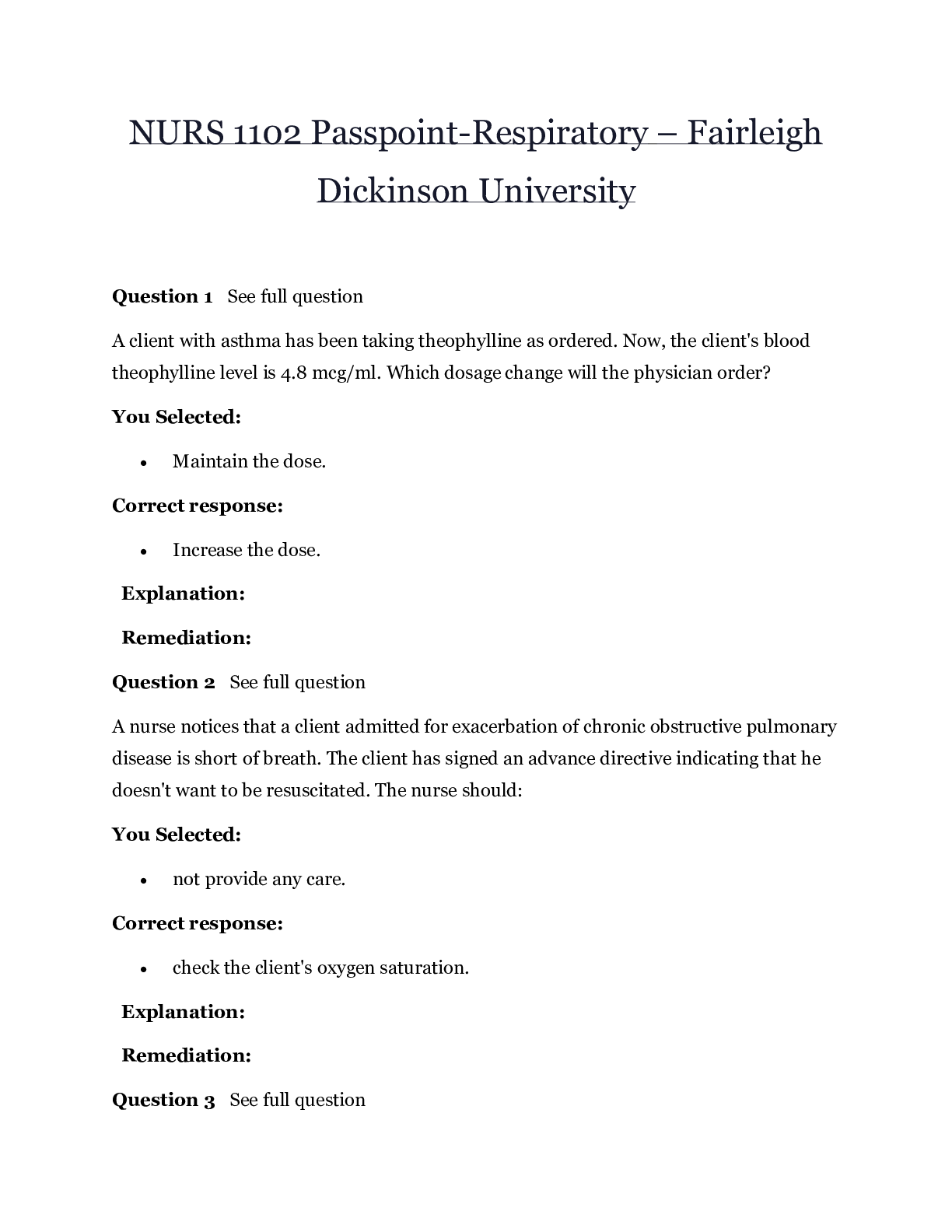
Buy this document to get the full access instantly
Instant Download Access after purchase
Add to cartInstant download
We Accept:

Reviews( 0 )
$16.50
Document information
Connected school, study & course
About the document
Uploaded On
Aug 15, 2020
Number of pages
207
Written in
Additional information
This document has been written for:
Uploaded
Aug 15, 2020
Downloads
0
Views
57














